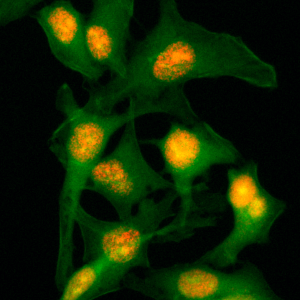anti-Histone H2B, Rabbit Monoclonal (RM230)
| Code | Size | Price |
|---|
| REV-31-1112-00-C025 | 25 ug | £254.00 |
Quantity:
| REV-31-1112-00-C100 | 100 ug | £553.00 |
Quantity:
Prices exclude any Taxes / VAT
Overview
Host Type: Rabbit
Antibody Isotype: Rabbit IgG
Antibody Clonality: Recombinant Antibody
Antibody Clone: RM230
Regulatory Status: RUO
Target Species:
Applications:
- Enzyme-Linked Immunosorbent Assay (ELISA)
- Immunocytochemistry (ICC)
- Multiplex
- Western Blot (WB)
Shipping:
BLUE ICE
Storage:
Long Term: -20°C
Images
Documents
Further Information
Alternate Names/Synonyms:
H2B
Concentration:
1 mg/ml
EClass:
32160000
Form (Short):
liquid
Formulation:
Liquid. 50% Glycerol/PBS with 1% BSA and 0.09% sodium azide.
Handling Advice:
Avoid freeze/thaw cycles.
Immunogen:
A peptide corresponding to the C-terminus of human Histone H2B.
Long Description:
Recombinant Antibody. This antibody reacts to the Histone H2B protein, independent of post-translational modifications. No cross reactivity with other histone proteins. Applications: WB, ELISA, Multiplex, ICC. Source: Rabbit. Liquid. 50% Glycerol/PBS with 1% BSA and 0.09% sodium azide. Histones are proteins that package DNA into nucleosomes. Histones are responsible for maintaining the shape and structure of a nucleosome. One chromatin molecule is composed of at least one of each core histones per 100 base pairs of DNA. There are five families of histones known to date; these histones are termed H1/H5, H2A, H2B, H3, and H4. H2B is considered a core histone, along with H2A, H3 and H4. H2A packages DNA molecules into chromatin and has been correlated with DNA modification and epigenetics. H2A plays a major role in determining the overall structure of chromatin and regulates gene expression. Protein modification on histone H2A exist and can sometimes result in a change in function. Different H2A variants were exploited to have different functions, genetic sequences and modifications. Histone H2B is a structural protein that helps organize eukaryotic DNA. It plays an important role in the biology of the nucleus where it is involved in the packaging and maintaining of chromosomes, regulation of transcription and replication and repair of DNA. Histone H2B helps regulate chromatin structure and function through post-translational modifications and specialized histone variants. Hyperacetylation of histone tails helps DNA-binding proteins access chromatin by weakening histone-DNA and nucleosome-nucleosome interactions. Acetylation of a specific lysine residue binds to bromine-containing domains of certain transcription and chromatin regulatory proteins. This docking facilitates the recruitment of these proteins to the correct region of the chromosome. Ubiquitinated histone H2B is often found in regions of active transcription and stimulates transcriptional elongation and sets the stage for further modifications that regulate multiple elements of transcription. In histone H2B, a phosphorylated serine or threonine residue activates transcription.
NCBI, Uniprot Number:
P06899
Package Type:
Vial
Product Description:
Histones are proteins that package DNA into nucleosomes. Histones are responsible for maintaining the shape and structure of a nucleosome. One chromatin molecule is composed of at least one of each core histones per 100 base pairs of DNA. There are five families of histones known to date; these histones are termed H1/H5, H2A, H2B, H3, and H4. H2B is considered a core histone, along with H2A, H3 and H4. H2A packages DNA molecules into chromatin and has been correlated with DNA modification and epigenetics. H2A plays a major role in determining the overall structure of chromatin and regulates gene expression. Protein modification on histone H2A exist and can sometimes result in a change in function. Different H2A variants were exploited to have different functions, genetic sequences and modifications. Histone H2B is a structural protein that helps organize eukaryotic DNA. It plays an important role in the biology of the nucleus where it is involved in the packaging and maintaining of chromosomes, regulation of transcription and replication and repair of DNA. Histone H2B helps regulate chromatin structure and function through post-translational modifications and specialized histone variants. Hyperacetylation of histone tails helps DNA-binding proteins access chromatin by weakening histone-DNA and nucleosome-nucleosome interactions. Acetylation of a specific lysine residue binds to bromine-containing domains of certain transcription and chromatin regulatory proteins. This docking facilitates the recruitment of these proteins to the correct region of the chromosome. Ubiquitinated histone H2B is often found in regions of active transcription and stimulates transcriptional elongation and sets the stage for further modifications that regulate multiple elements of transcription. In histone H2B, a phosphorylated serine or threonine residue activates transcription.
Purity:
Protein A purified.
Source / Host:
Rabbit
Specificity:
This antibody reacts to the Histone H2B protein, independent of post-translational modifications. No cross reactivity with other histone proteins.
Transportation:
Non-hazardous
UNSPSC Category:
Primary Antibodies
UNSPSC Number:
12352203
Use & Stability:
Stable for at least 1 year after receipt when stored at -20°C.



